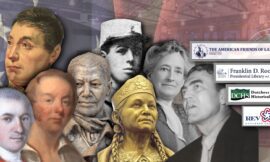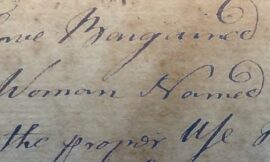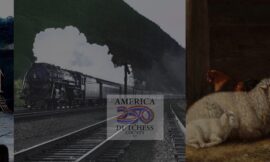18th Century

1824: Lafayette in Dutchess County
Big Moves & Intimate Gestures. Why Lafayette’s approach to equality has meant so much to so many. Below is a continually evolving concept that looks at Lafayette through the hearts & minds of those in his 1824 diverse, record-size audiences (and later audiences well into the 20th century) who were at greatly varying degrees of success in realizing the American promise of equality. An in-depth look here: Click full screen icon bottom-left for best view A quick summary below: September 16, 2024 will mark the 200th anniversary of Lafayette’s visit to Dutchess County’s Poughkeepsie and Staatsburg — and Columbia County’s Clermont and Hudson. September 19 will mark the same anniversary for his visit to Red Hook and Fishkill Landing. Part of a 13-month tour of all 24 states, he was the “nation’s guest” at the instigation of President James Monroe, at the invitation of Congress. They sought to rally and unify the country as it approached its 50th anniversary: July 4, 1826. Monroe’s sense that time was running out was prescient. Both John Adams and Thomas Jefferson died on that day. Monroe died July 4, 1831. Lafayette died in 1834 in France. Called a man of two worlds because of his role in the 1776 American Revolution and the French Revolution at the end of the following decade, he was only 19 years old when Congress made him a Major General. In addition to citations for bravery and effectiveness in the military, he contributed his personal wealth, and persuaded the King of France to formally and actively support the American cause. Green indicates public events. Blue indicates private visits. A firm commitment to truth. Big moves & intimate gestures. Toward the end of his life, Lafayette called for a strict adherence to truth. He said that moderation is not the average between two points, but a firm grip of the truth. “When it is said that four and four make eight and an extravagant person pretends that it makes 10, is it more reasonable to maintain that four and four make nine? No, true moderation is discovering what is true, and firmly abiding by it.” Nowhere is this more evident than his views and actions and commitment the idea that all are created equal. To Lafayette, all meant all. In Lafayette we find a very distinct combination of big moves, such gaining the support of France in the American cause, or his own personal support of the same, and small gestures, like kissing the hand of Marie Antionette to calm an angry crowd, or the tip of his hat to an enslaved Kentucky boy (Lewis Hayden shown above) who said that inspired him to become the nationally known abolitionist that he was. American Indians. Big moves: Lafayette assisted the Oneida Nation, America’s ally during the Revolution, with fortifications of their settlement and persuaded them to send 47 of their soldiers to join the Continental Army. They gave him the name Kayewla, or Great Warrior. Small gesturees: Not seeing any Oneida on his June 10, 1825 visit to Utica, a former Oneida stronghold, Lafayette asked his hosts about them, surprising them with the request. When the Oneida came, they had a private audience with Lafayette that he had not granted others. Free and enslaved Blacks: Big moves: Lafayette enlisted James Armistead, an enslaved man in Virginia who had earned a temporary reprieve from his owner, to became an invaluable double-agent spy, infiltrating the highest levels of the British military. Small gestures: but was returned to being enslaved at the end of the war and was denied a pension for lacking a combat role. Lafayette successfully personally petitioned congress on both accounts. White working-class and poor: Big moves: There is less of a direct connection, but an important one nonetheless. For much of his tour, Lafayette travelled with a close friend, Frances “Fanny” Wright. Within a few years, she be so aligned to the Working Men’s Party that the party became known as the Fanny Wright party, and its candidates Fanny Wright men. Small gestures: The Poughkeepsie Telegraph reported that at Forbus house, “We observed among [the crowd] an old revolutionary soldier bearing the marks of poverty and hardship, but whom the general recognized. And it was gratifying to see with what cordiality they shook hands. The old soldier was obliged to yield to the pressure of the crowd and passed off with his eyes sparkling and his countenance lighted up, and was evidently inspired with a new glow of life.” Fanny Wright became close to Lafayette immediately upon meeting him in France in 1821. She travelled with him on a good portion of his 1824/1825 tour including a stay with Jefferson at Monticello. She went on to become associated with the Workingmen’s Party. Lafayette penned a successful letter of support in James Armistead’s request for freedom, which had prior been denied. When Lafayette arrived in Utica in 1825, he insisted the Oneida be invited, who he granted. aprivate audience.
Posted in: 18th Century, For everyone, Veterans

Slavery: Bill of Sale
DCHS Collections Documents of Enslavement A woman named Rachel is “sold” to Christian Tobias on February 4, 1771 Know all men by these presents that I [Mical?/Michael] Obberocker of Beekman Precinct in Dutchess County do for the consideration of the sum of 65 pounds good and lawful money of New York to one in hand paid by Christian Tobias of Charlotte Precinct in said County, have bargained, sold [ ] and delivered one certain Negro woman named Rachel for term of life to have and to hold to the proper use benefit and [ ] of him the said Christian Tobias his heirs executors and assigns… February 4, 1771 Signed in the presence of Bartholomew Noxon, Jr. and Thomas Tobias.
Posted in: 18th Century, African Heritage, For everyone
The Hudson River as Battlefield
THIS PAGE IS UNDER CONSTRUCTION TO AN UPDATED PLATFORM, THANK YOU FOR YOUR PATIENCE… This online exhibition offers insights into the October 1777 British action, as well as insights into Franklin Roosevelt’s unrelenting commitment to the understanding and publication of local history even as global war emerged and commenced. jump to FDR’s Yearbook Articles on the October 1777 event jump to British Ship Logs Obtained by FDR jump to June 1777 Livingston Letter: Me Worry? Won’t Happen! jump to What a Cannonball Can Do George Washington called West Point, just south of Dutchess County on the Hudson River, the key to the North American Continent. Historians agree the success of the American patriots relied on the defense of the Hudson River Valley, which the British where the British hoped to take control to divide the emerging United States in half. In October of 1777 a single trip north by the British as far as Red Hook, Dutchess County, did show the potential for such a raid, and resulted in the complete destruction of the capital of New York at the time, Kingston. Certain homes, barns with agricultural products, and stores were targeted with cannon ball or were torched and burned. The dramatic event would attract the attention of any local historian. But the fact that the ships traversed the area of Franklin Roosevelt’s ancestral homes, gave it an extra dimension and power for him. FDR’s Yearbook Articles President Roosevelt wrote an article for each of the 1935 and 1936 DCHS Yearbooks, where his trusted partner, Helen Wilkinson Reynolds was editor. DCHS’s Helen Wilkinson Reynolds. back to top British Documents DCHS Collections: Envelope containing information from the British Admiralty directed to FDR, who then gave them to DCHS. The articles are written about the material he obtained through requests to the head of the British Admiralty and the US Embassy in London. Britain’s Lord Halifax shown at right. Middle top: with Nazi leader Herman Goering. Middle bottom: with British Prime Minister Winston Churchill. Right: with FDR. When Halifax was made US Ambassador in 1941, FDR broke with protocol and met Halifax in his private sloop. back to top Henry Livingston, Sr. Letter Poughkeepsie June 16, 1777 Loving Brother, Your negro just now delivered me the Bond and Tenant Books with your letter of the 7th instant and am sorry you are again attacked with the gout. Your being so long freed was in hopes it would have quitted you. Captain Phillip Cortland was here this morning and left Peeks Kill yesterday all in quietness and the Armies in Jersey as yet very peaceable. As for the English Army coming up this river I am under no apprehension of, because I think it would be great madness in attempting it. We are all in good health and join in our love to your sister and children. And am… your loving brother, Henry Livingston. back to top Henry Livingston, Jr. House The son of the author of the letter found his home hit by a single cannonball. The 1919 DCHS Yearbook published a photograph of the patched shingle at the front of the house (right). Among the artifacts in DCHS Collections is the beam that was damaged by the cannonball in 1777 (below). It was removed when the house was demolished in the late 19th century. back to top
Posted in: 18th Century, Countywide, For everyone

Rev250
There is no better way to understand the present and gain insights into the future than the study of history, especially when it comes to the study of the founding of our country and the establish of our basic rights and responsibilities. Within these pages, DCHS, with the broader Dutchess County history community, is looking to develop an understanding of these kinds of questions that will evolve into a permanent online exhibition and educational resource.
Posted in: 18th Century
Washington’s 1792 Visit to Poughkeepsie
Posted in: 18th Century, Decoding Dutchess Past, For everyone, Poughkeepsie

